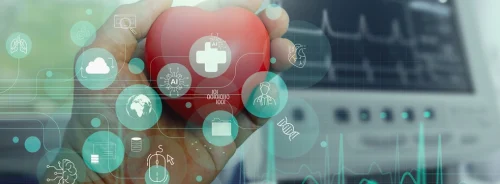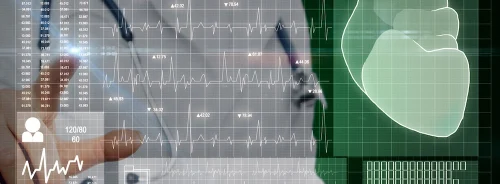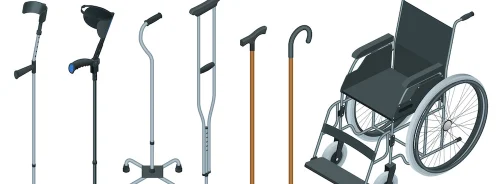Authors
Dr. Gabriel Meinhardt
Prof. Udo Sechtem
Department of Cardiology
Robert Bosch Krankenhaus
Stuttgart, Germany
Coronary artery disease (CAD) is the leading cause of mortality in the industrial world. Cardiac imaging is essential to establish the diagnosis and severity of CAD and to determine the potential risk of future cardiovascular events. In patients with suspected CAD, evaluation of patient history will reveal the presence of cardiac risk factors and typical symptoms. An ECG should be performed in all patients with suspected CAD. This article explores the different methods for imaging cardiac diseases, reviews the pros and cons of each method.
Echocardiography
This painless, non-invasive test uses sound waves to create 2D images of the cardiovascular system. New systems also produce 3D images. With the help of Doppler ultrasound it also produces information about the velocity of blood flow in the heart and measures heart valve function. A transducer is placed on the chest wall of the patient in order to transmit and receive acoustic signals. The size of all four heart chambers is measured and left and right heart chamber function is assessed. Echocardiography is simple, can be performed quickly, and is radiation- and risk-free. Echo machines are mobile and can hence be used everywhere. However, image quality is insufficient in some patients.
Stress Echocardiography
Stress can be used to detect or exclude stenoses of the coronary arteries and can be performed on a treadmill or a bike. In patients who cannot exercise, drugs can be used as alternative stressors. A properly performed stress echocardiogram with a normal result excludes a significant stenosis of a coronary artery with a high level of confidence. The main limitation of the test is its dependence on a welltrained operator. In some patients, image quality is not sufficient to perform a stress echocardiogram.
Trans-Oesophageal Echocardiography (TEE)
A TEE can be performed with the same machine as a standard echocardiogram, but it requires a different probe. During this test, the patient is sedated. The small probe, containing an ultrasound transducer at its tip, is placed down the patient’s oesophagus. Being close to the heart, the ultrasound has only a small way to travel.
Structures including both atria, the atrial septum, the left atrial appendage, the heart valves, and the aorta of the heart can be visualised with more detailed images than with the standard trans-thoracic echocardiogram. Heart valve abnormalities can be seen with high image quality. The limitation of the test is its semi-invasive nature but the risk of the test is very low. Despite sedation the test may be uncomfortable for some patients. The coronary arteries cannot be visualised.
Table 1. Utility of different imaging modalities in different heart diseases. HD denotes heart disease. +++ = very useful; ++ = useful; + = of limited use; - = not useful.
Nuclear Imaging
Stress myocardial perfusion imaging with single-photon computed tomography (SPECT) uses radioactive tracers to gather information about regional blood flow, coronary artery perfusion and ventricular function and has a high diagnostic accuracy in patients with suspected CAD. In patients incapable of exercise, pharmacologic stress SPECT has comparable accuracy. A normal perfusion scan is associated with an excellent outcome. With newer radioactive tracers the size and function of the left ventricle can be measured. The primary disadvantages are radiation exposure and the expense of the procedure.
Image 1: TEE. Panel A: TEE in a patient with a stenosis of the aortic valve. The calcified leaflets and the reduced opening are clearly shown. LA: left atrium. RA: right atrium. AC: calcified aortic cusps. AVA: aortic valve area at maximal opening.
Panel B: TEE in a patient with a mitral valve prolapse and severe mitral regurgitation. The posterior leaflet of the mitral valve is displaced towards the left atrium. LA: left atrium. LV: left ventricle. AV: aortic valve. PML: posterior mitral leaflet. AML: anterior mitral leaflet.
Panel C: same patient as in Panel B. with colour Doppler: the regurgitant jet from the left ventricle through the mitral valve in the left atrium. RF: regurgitant flow.
Image 4: Stress echocardiography. The left ventricle is shown in the long axis view.
Panel A: Relaxed muscle at rest.
Panel B: Contracted muscle at rest. Normal contraction of all visible parts.
Panel C: Relaxed muscle at peak stress.
Panel D: Contracted muscle at peak stress: normal contraction and thickening of the inferior wall (black arrow). Reduced contraction (hypokinesia) of the anterior wall and the apex (white arrow) indicative of a stenosis of the left anterior descending coronary artery.
Image 2: Noninvasive coronary angiography with 16-row computed tomography.
Panel A: Reconstructed image of the right coronary artery with high grade stenosis (white arrow), confirmed by cardiac catheterization (panel B). RCA: Right coronary artery. RV: Right ventricle. LV: Left ventricle.
Image 3: Cardiac MRI. Short axis images of the left ventricle.
Panel A: Stress perfusion MRI at rest.
Panel B: Stress perfusion MRI after adenosine. An area of the inferior wall is hypoperfused and remains darker than the adjoining myocardium (arrow) indicating the presence of a stenosis of the right coronary artery.
Coronary Angiography and Left Heart Ventriculography
Coronary angiography is an invasive method of visualising the coronary arteries. In most cases, a catheter is inserted in the groin and pushed to the heart. The coronary arteries are filled with contrast media so the internal lumen of the coronary tree can be seen and all stenoses can be demonstrated. The outer parts of the coronary arteries can’t be seen as only contrast media or calcified structures appear on the radiographic images. Image resolution of the coronary tree is higher than with any other method.
If a stenosis or occlusion of a vessel is found, an intervention can be performed during the same session. In patients with acute myocardial infarction with elevation of the ST-segments in the ECG, immediate coronary angiography can save lives. The left ventricle can be filled with contrast medium and contractions of the left ventricular myocardium demonstrated. The disadvantages of coronary angiography are radiation, the need for contrast media and its invasiveness.
Table 2. Advantages and disadvantages of different imaging modalities in patients suspected of having CAD.
Magnetic Resonance Imaging
Cardiac MRI is the most accurate technique for evaluating ventricular size and function. It is useful in the evaluation of cardiac masses and congenital heart disease.
Cardiac MRI angiography is a standard technique for imaging the aorta and the large vessels. After administration of gadolinium-containing contrast material, myocardial infarction scars can be detected with a sensitivity unparalleled by any other technique and characteristic patterns of contrast enhancement can be visualised in a variety of myocardial diseases like amyloidosis and hypertrophic cardiomyopathy.
The disadvantages of cardiac MRI are the expense and the need for contrast material although MR contrast agents are not nephrotoxic. However, serious sideeffects were recently described in patients with renal failure.
Computed Tomography
With CT of the heart, either coronary calcifications can be measured or a noninvasive coronary angiography can be performed. No contrast material is needed. The amount of coronary artery calcium is indicative of the atherosclerotic plaque burden and is associated with the cardiac prognosis. However, the amount of coronary calcium does not correlate with the focal stenosis severity of a given lesion and is therefore unhelpful in predicting the necessity of an intervention.
High resolution noninvasive coronary angiography is now feasible. 64-slice multi-detector CT has good sensitivity and a high specificity for the exclusion of high-grade coronary stenoses.
Disadvantages of CT angiography are high radiation exposure and the need to administer contrast media.
Summary
Echocardiography is the main noninvasive imaging method in heart disease. It is quickly performed, relatively cheap and has no side effects. A good echocardiography laboratory is thus mandatory in all cardiology departments.
In patients suspected of having CAD who have an ambiguous stress-test or are not able to exercise stress echocardiography or SPECT myocardial perfusion imaging should be performed. Which technique is performed depends on local expertise and availability. Stress echocardiography has the advantage of not being accompanied by radiation exposure. Expertise in at least one of the techniques should be maintained in all cardiology departments. With coronary angiography, an optimal morphologic diagnosis can be established which may be the basis for an intervention performed in one session.
In the last few years, cardiac MRI and cardiac CT have shown great promise in patients with CAD and other heart diseases. Cardiac MRI has been shown to be very useful in a variety of myocardial diseases. Cardiac CT is able to visualise coronary artery stenoses with high accuracy. However, their role in patients with suspected CAD and other heart diseases has yet to be defined precisely.





